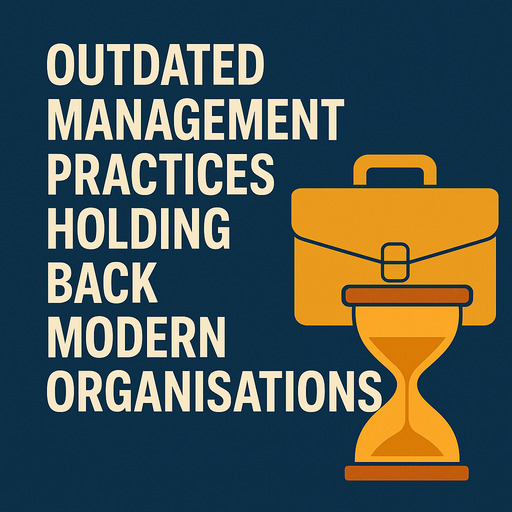 Most organisations still run on management practices designed decades—sometimes centuries—ago. They made sense when communication was slow, information was scarce, and work was repetitive.
Most organisations still run on management practices designed decades—sometimes centuries—ago. They made sense when communication was slow, information was scarce, and work was repetitive.
But here’s the problem: the world has changed, and these practices haven’t. In many cases, they’ve become organisational anachronisms—habits that linger not because they’re effective, but because “that’s how we’ve always done it.”
Consider this: organisations once cascaded messages down hierarchies because mass communication wasn’t possible. Representative democracies arose because citizens couldn’t practically vote on every issue when travel meant days on horseback. Both structures made sense in their time. But in an age of instant communication, we should question whether these models still serve us.
So what other outdated management practices might be holding your organisation back?
11 Outdated Management Practices
The 9–5 Workday
Born in the industrial revolution to regulate factory shifts, the 9–5 model makes little sense for knowledge work. Creativity and problem-solving don’t fit neatly into fixed hours, and remote work has shown that productivity is not bound to a time clock.
Annual Performance Reviews
Designed for a paperwork-driven age, yearly appraisals deliver feedback far too late to be useful. Today, employees expect continuous coaching and real-time insights into their performance.
Rigid Org Charts
Military-inspired command structures once ensured clarity and discipline. But rigid hierarchies now slow execution, discourage innovation, and block collaboration across functions.
Static Job Descriptions
In the industrial era, roles were repetitive and could remain unchanged for years. Now, static job descriptions prevent adaptability and cross-skilling—exactly the traits organisations need in fast-moving markets.
Departmental Silos
Finance, HR, and Marketing departments made sense for paper-based filing systems and clear accountability. But today, strategy and customer needs cut across these silos, and the resulting duplication slows down progress.
Meetings as the Default Tool
When people couldn’t share documents or data easily, meetings were the only way to align. With digital collaboration platforms, many meetings are redundant—but still consume huge chunks of executive time.
Management by Presence
In factories, being present equated to productivity. But in knowledge work, output and creativity matter far more than desk time. Still, presenteeism continues to drive promotions in many organisations.
Quarterly and Annual Reporting as the Primary Lens
Accounting cycles dictated periodic reporting. But focusing narrowly on quarterly results distorts decision-making and undermines long-term strategy in fast-changing markets.
Titles as the Only Path to Progress
Hierarchies once made promotions the only way to gain influence. Today, project-based leadership, expertise, and flexible recognition matter just as much as job titles.
Email as the Default Communication Channel
Email was the digital equivalent of memos and letters—great in its time, but poorly suited for real-time collaboration. Yet many organisations remain buried in overflowing inboxes.
The Annual Strategic Planning Cycle
The annual strategic offsite attended by a few select individuals, resulting in a signed-off plan to be handed down into the organisation for execution is poorly suited to today's complex, interconnected and fluid environment.
Where Do We Go From Here?
 The real challenge isn’t identifying these outdated practices—it’s replacing them with systems designed for today’s possibilities, not yesterday’s constraints.
The real challenge isn’t identifying these outdated practices—it’s replacing them with systems designed for today’s possibilities, not yesterday’s constraints.
That means:
-
Shifting from time-based to outcomes-based work.
-
Embracing fluid, cross-functional teams.
-
Providing feedback and data in real time.
-
Aligning strategy execution across silos.
The question for leaders is simple: are you managing for the constraints of the 1950s, or for the opportunities of 2030?
If you’re ready to rethink how strategy is developed and executed in your organisation, why not take the first step?
👉 Try StratNavApp.com for free
👉 Schedule a demo of StratNavApp.com
👉 Book a call to discuss your needs
